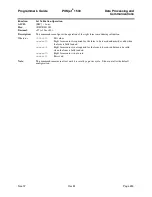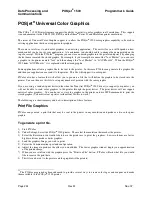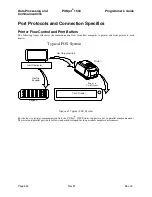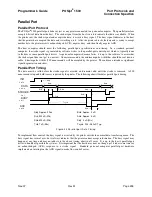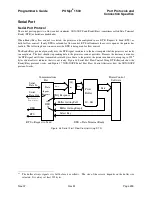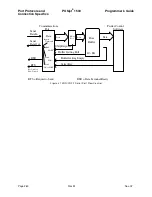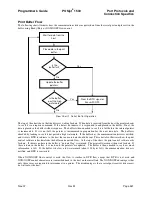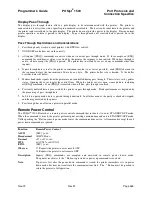
Programmer's Guide
POSjet
®
1500
Port Protocols and
Connection Specifics
Nov-07
Rev M
Page 255
Parallel Port
Parallel Port Protocol
The POSjet
®
1500 parallel port behaves just as any printer connected to a personal computer. The parallel interface
accepts 8-bits of data from the host. The strobe signal from the host is used to indicate that data is available. When
the printer sees the strobe signal and accepts the data, it asserts a busy signal. The busy signal indicates to the host
that the printer has accepted the data and is working on it. After the printer absorbs the data and is ready to accept
another byte, the printer asserts acknowledged (ACK), negates busy, and then finally negates ACK.
The host computer should meet the following parallel-port specifications and timing. In a standard personal
computer, the strobe signal is generated by software writes to the parallel-port control port, which is typically done
in the bios or some parallel-port driver. As personal computers become faster, it is up to the software to assure that
the strobe signal does not get too narrow. One microsecond is the minimum pulse width that should be sent down a
cable. Shorter pulse widths (500 nanoseconds) will be accepted by the printer. The cable can introduce significant
signal degeneration and skew.
Parallel Port Timing
The data must be valid before the strobe signal is asserted, and remain valid, until the strobe is removed. A 500
nanosecond setup and hold time is required by the printer. The following chart illustrates parallel-port timing.
INIT
DATA
STROBE
BUSY
ACK
Pin 16
Pin 2-9
Pin 1
Pin 11
Pin 10
<-- Dhld
<--Tstb
Dstu--->
<
>
>
Bhld--->
<
Ahld ---->
<
Sdly ----->
<
Dstu 500 nS (Min)
Dhld 500 nS (Min)
Tstb 1 uS (Min)
Bhld Approx. 5 uS
Ahld Approx. 5 uS
Sdly 3 uS (Min)
Data
Data
< ---- Rdly
Rdly Approx. 2 Sec.
<----------------
--------------->
Tcycle
Tcycle 200 - 280 uS Typ.
Figure 34 Parallel-port Data Timing
To implement flow control, the busy signal is asserted by the printer outside the normal data-transfer sequence. The
busy signal has several uses, but it always indicates that the printer cannot accept information. The busy signal may
happen at any time and may not adhere to the above timing chart in all cases. It is up to the host's parallel-port
driver to handle all possible busy states. It is important that the host driver does not hang up if it takes some time for
an acknowledged (ACK) response to a strobe signal. Standard personal computer parallel-port hardware
implements an interrupt on the ACK signal to make flow control easier.
Содержание POSJET 1500
Страница 1: ...PROGRAMMER S GUIDE POSjet 1500 PN 20 03398 Rev M Nov 2007...
Страница 14: ......



